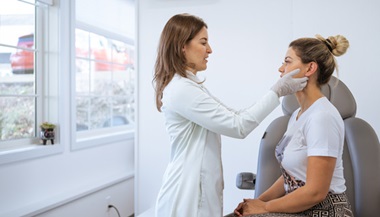Cheek Implants
As people age, the tissues of the face can become thinner and less firm. Adding volume to the cheek areas or middle of the face below the eyes with implants can improve facial contours and impart a more youthful appearance to the face.
Cheek implants can also restore a more natural appearance to the face after reconstructive surgery for cancer, other illness or traumatic injury.
What You Need to Know
- Cheek implants are removable and can be made of silicon. The surgeon may also opt to use fillers or materials that bind directly with the cheekbones.
- Scarring is seldom an issue with cheek implants since the surgeon is likely to insert the implant through an incision inside the mouth or lower eyelid.
- It is important for plastic surgeons to approach cosmetic procedures of the face in a holistic manner, looking for balance and harmony between each area of the face and its proportions.
About Cheek Implants
There are three general shapes to cheek implants:
- Malar – These implants are placed directly on the cheekbones, providing higher projection.
- Submalar – These implants provide fuller cheeks, rounding out a gaunt, or sunken, appearance.
- Combined – A combined implant augments both the cheekbones and the cheeks.
Facial implants are solid implants typically made of medical silicon, which has a long, established record of safety. The surgeon may choose from a variety of implants, depending on the desired approach. Facial implants are intended to be permanent, but the implants can be removed if desired.
What to Expect After Cheek Implant Surgery
-
The surgeon will put a dressing on the person’s face immediately after surgery, and this dressing will remain in place for two to three days. The person will experience some tenderness. Post-operative discomfort may be controlled with prescribed medications.
-
Most people feel a stretched, tight sensation in the cheek area after getting cheek implants or fillers, but this usually subsides in a week.
-
After about six weeks, most swelling goes down and people can start to see results. The doctor may recommend avoiding rigorous activity for the first few weeks after surgery, but most people can resume normal activities after about 10 days.
Note: These are general guidelines and may not apply to each individual’s situation. Please ask your doctor to fully explain what you can expect after surgery.
Follow-Up Care
Follow-up care is vital for this procedure to monitor healing. Unusual swelling, bleeding, fever or other symptoms should be reported to your surgeon immediately. Patients should ensure that they keep all follow-up appointments with the surgeon to ensure healing is taking place normally.
Seminar Saving Face: Advice to Help Freshen Aging Skin

Age-related changes to the face don’t have to be noticeable. Learn about surgical and nonsurgical options to address signs of aging from Dr. Kofi Boahene.





